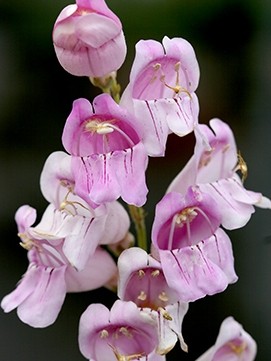Roezl's penstemon
(Penstemon roezlii)

Description
Penstemon roezlii is a species of penstemon known by the common name Roezl's penstemon. It is native to Oregon, western Nevada, and adjacent sections of northern California, including the Klamath Mountains and Sierra Nevada, where it grows in sagebrush and forest habitat types. It is a hairy, erect perennial herb growing to a maximum height of 55 centimeters from a woody, branching base. The leaves are up to 7 centimeters long, linear to widely lance-shaped and often folded lengthwise. The glandular inflorescence bears wide-mouthed tubular flowers up to 2.2 centimeters long in shades of blue-purple. The flowers are mostly hairless except for thin glandular hairs on the outer surfaces. Penstemon the beardtongues, is a large genus of roughly 250 species of flowering plants native mostly to the Nearctic, but with a few species also found in the North American portion of the Neotropics. It is the largest genus of flowering plants endemic to North America. Formerly placed in the family Scrophulariaceae by the Cronquist system, new genetic research has placed it in the vastly expanded family Plantaginaceae. They have opposite leaves, partly tube-shaped, and two-lipped flowers and seed capsules. The most distinctive feature of the genus is the prominent staminode, an infertile stamen. The staminode takes a variety of forms in the different species; while typically a long straight filament extending to the mouth of the corolla, some are longer and extremely hairy, giving the general appearance of an open mouth with a fuzzy tongue protruding and inspiring the common name beardtongue. Most penstemons are deciduous or semi-evergreen perennials, the remainder being shrubs or subshrubs. Heights can range from 10 cm to as much as 3 metres. The one Asiatic species previously treated in Penstemon is now placed in a separate genus Pennellianthus. This leaves Penstemon a mostly Nearctic genus, with a few neotropical species. Although widespread across North America, and found in habitats ranging from open desert to moist forests, and up to the alpine zone, they are not typically common within their range. John Mitchell published the first scientific description in 1748; although he only named it as Penstemon, we can identify it as P. laevigatus. Linnaeus then included it in his 1753 publication, as Chelone pentstemon, altering the spelling to better correspond to the notion that the name referred to the unusual fifth stamen (Greek "penta-", five).
Taxonomic tree:







